Thursday, 5 June 2014: Albi, Toulouse-Lautrec
Written 16 June
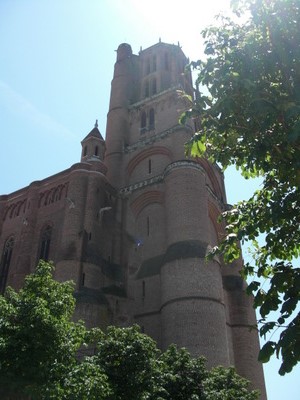
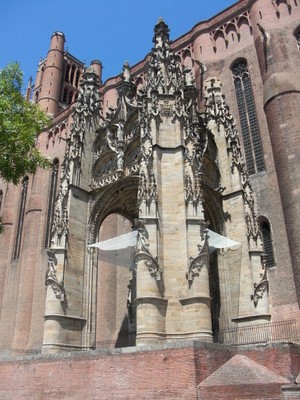 The very first thing that strikes you about Albi's Cathedral of Saint Cecilia—smacks you in the face, almost—is that it's made of bricks! And I mean a lot of bricks. It and its adjoining bishop's palace are the largest brick religious structure, and one of the largest brick structures of any kind, in the world. Somehow that detail had escaped us until we rounded that last corner and there it was, looming over us.
The very first thing that strikes you about Albi's Cathedral of Saint Cecilia—smacks you in the face, almost—is that it's made of bricks! And I mean a lot of bricks. It and its adjoining bishop's palace are the largest brick religious structure, and one of the largest brick structures of any kind, in the world. Somehow that detail had escaped us until we rounded that last corner and there it was, looming over us.
The only part that's stone is the south doorway, shown here at the right. Whereas the rest of the structure is pretty spare, the doorway is rampant flamboyant gothic, a fore-taste of the staggering decoration within. But that's not what we'd come to town to see, so that Thursday morning, we continued around the building to the bishop's palace (called the Palais de la Berbie; "berbie" is a corruption of an Occitan word meaning "bishop's residence"), which houses both the Office de Tourisme and the museum of Albi's favorite son Henri de Toulouse-Lautrec.
Unfortunately, the museum allows no photography. On the other hand, the city of Albi has a great web site with a magnificent interactive aerial view of the cathedral and excellent "virtual tour" of the museum, so you can see a lot of the inside that way. Check it out at http://www.mairie-albi.fr/pano/albi_virtuel.htm.
Toulouse-Lautrec was not a dwarf, but because of a genetic disorder (his parents were first cousins), he broke his femur as a child, then, less than a year later, broke the other one. (The disease is thought to have been pycnodysostosis, which causes dense, brittle bones and short stature.) From that point on, although his torso developed normally, his legs never grew again, leaving him quite short; for the rest of his life, he used a cane and could never ride again.
Unlike the Goya museum with very few Goyas, this museum consists almost entirely of Toulouse-Lautrec's own work, plus some portraits of him by others. One room that had been intended to house part of the poster collection, was set aside, however. When it was cleaned out and restored, the workers found its original glazed tile floor, so rather than using it to display art, they build boardwalks to keep foot traffic off the tile and use it instead to display the building's architecture. The floor repeats the pattern we saw in the Greek house in Narbonne—a contrasting pattern of tile defines one end of the room as the "antechamber," separate from the main area.
Having known his work primarily from his posters, I had never realized how many other kinds of art Toulouse-Lautrec produced. In particular, especially early and late in his life, his love of horses shows through in many paintings of them, from quick action sketches to a portrait of a white horse named "Gazelle," just the head and neck, that is, in my humble opinion, every bit as good as Whistlejacket.
He also painted wonderful portraits, including several of his mother. Some, especially of some of the artists he later did posters for, were described as "impitoyable"—merciless. He apparently never distinguished between his "real" art and his posters advertising establishments in Paris and often hung them together in exhibitions.
The museum has many of the studies and preparatory sketches he did for posters and paintings and many paintings he executed on colored cardboard (the color obviated the need for underpainting), using very dilute oils; the oil soaked into the cardboard leaving only the pigment on the surface, for an effect resembling pastelsz—lovely but very fragile.
A whole room is devoted his relationship with performer Jane AVril, and we saw a series of paintings of brothel interiors; he apparently hung around until he was considered part of the furniture and could capture very natural behind-the-scenes tableaus.
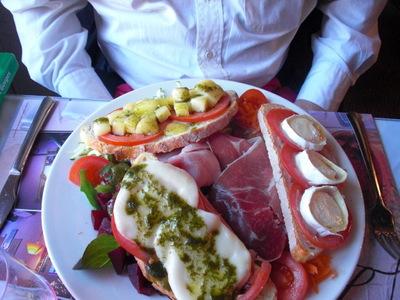
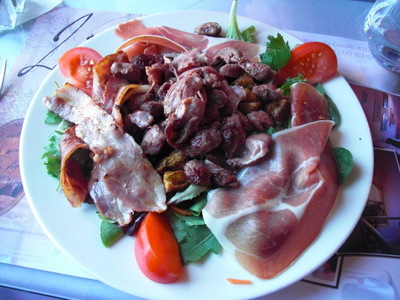 We were at the door when the museum opened in the morning and hadn't finished by the time it closed at noon, so we retrieved our stuff from the thoughtfully provided locker room and headed out in search of lunch, which we found no farther away than the adjoining square at a place called "l'Herytage." Salads as usual, David's with raw ham and three cheeses on toast (mozzarella, chevre, and Cantal, this time I think) and mine with ham, bacon, and poultry gizzards.
We were at the door when the museum opened in the morning and hadn't finished by the time it closed at noon, so we retrieved our stuff from the thoughtfully provided locker room and headed out in search of lunch, which we found no farther away than the adjoining square at a place called "l'Herytage." Salads as usual, David's with raw ham and three cheeses on toast (mozzarella, chevre, and Cantal, this time I think) and mine with ham, bacon, and poultry gizzards.
Also as usual, we found ourselves finished with lunch long before the museum reopened at 2 p.m., so we used the time to look at the interior of the cathedral. We stopped for a moment outside to admire the bronze panel illustrating the building in metal relief, labeled in braille, then passed with only a little trepidation under the heavy-duty netting strung under the stone vaulting of the entryway (clearly, they have a little falling-rock problem) before stepping inside, where we were dazzled.
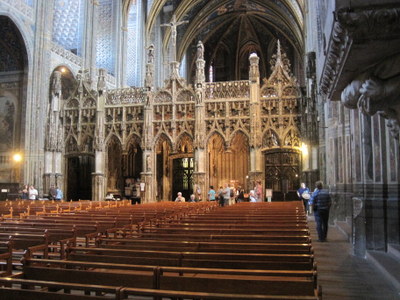
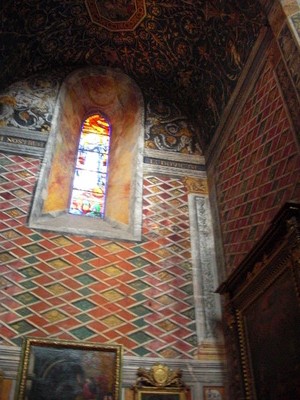 The usual line you get when you enter yet another another cathedral is "too bad the rood screen is gone; it was really spectacular" and "of course, back in the day, the walls and ceiling would have been painted rather than bare stone; just over there you can see some traces of paint." Not here!
The usual line you get when you enter yet another another cathedral is "too bad the rood screen is gone; it was really spectacular" and "of course, back in the day, the walls and ceiling would have been painted rather than bare stone; just over there you can see some traces of paint." Not here!
The rood screen (left, the partition that separated the nobles and religious orders in the choir from the rable in the nave) is still there (a great rarity in France) and it is truly spectacular. We learned later that the reason the carving could be so detailed is that the stone is relatively soft when quarried but hardens with age, so the sculpters got busy with chisels the size of dental instruments while it was fresh.
And the walls and ceiling are entirely covered with a dizzying array of painting, both figurative and abstract. We were told the walls had had some cleaning and restoration, but the ceiling is entirely original. I can't believe how well that intense blue has held up for all those centuries! And all the figures are just as crisp and clear as when they were painted.
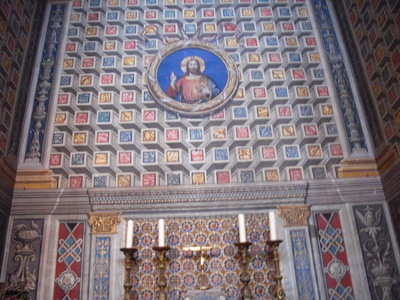
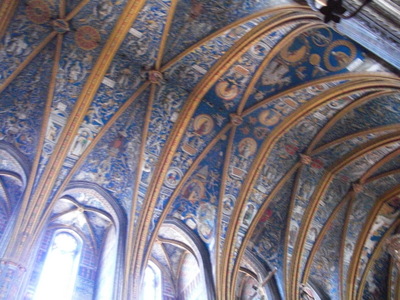 At the left here, note that amazing 3-D effect of square posts protruding toward the viewer. That's all trompe l'oeuil; the wall is perfectly flat, so all the relief, 3-D effects, etc. are painted on. The same is true of the wall at the right above; it's all painted on flat plaster. The 3-D effect is even more striking in person. The ends of the "protruding" posts are all different, hand patterned to look like colored marble.
At the left here, note that amazing 3-D effect of square posts protruding toward the viewer. That's all trompe l'oeuil; the wall is perfectly flat, so all the relief, 3-D effects, etc. are painted on. The same is true of the wall at the right above; it's all painted on flat plaster. The 3-D effect is even more striking in person. The ends of the "protruding" posts are all different, hand patterned to look like colored marble.
Each panel in the ceiling and each chapel around the nave is different, so the artists showed great creativity in coming up with both subjects and backgrounds.
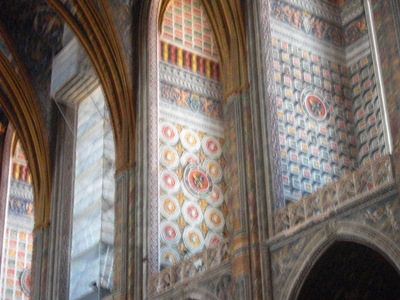
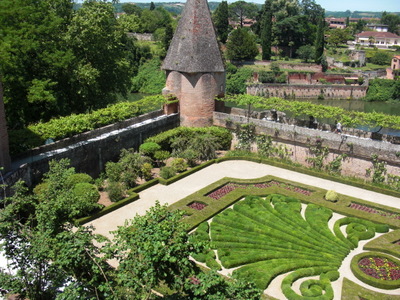 Because the painting carried on up the walls, past the clerestory windows, and onto the ceiling far above our heads, I was glad I'd brought my binoculars. You could sit there for hours, leaning back in a pew, studying all the images.
Because the painting carried on up the walls, past the clerestory windows, and onto the ceiling far above our heads, I was glad I'd brought my binoculars. You could sit there for hours, leaning back in a pew, studying all the images.
Without paying admission, all we could see was the nave. It has no west door opposite the apse; the only entrance is the elaborately carved stone baldaquin we came in through. Where the west door would have been is a large chapel. Apparently, when the mass started being said within sight of the rable, they just reversed their field and said mass at that end, rather than removing the rood screen. Good call. We decided not to spring for access to the choir and the audioguide.
The museum still hadn't opened by the time we got back, so I explored, looking for outdoor access to the bishop's garden (shown at right), which we had been able to see from windows of the museum. Yes, you can get there from the museum courtyard, but it involved climbing down three flights of stairs, which you'd have to climb back up to get out again, so I just took this photo from the top and skipped the actual visit. From the museum we could see people strolling around the walkway under the arbors that meet at the round tower, but I'm not sure whether you could get down into the center part or not.
Back in the museum, we finished the last couple of rooms of Toulouse-Lautrec, and right at the end, chanced across an auditorium that was showing a film about his work. Very informative—I wish we'd seen that first, before seeing the paintings themselves.
The film explained that his mother had had him confined to a "sanatorium" a couple of years before his death, because he had been drinking too much and having health problems. He kept writing her lucid letters and making beautiful, masterly drawings during his confinement and eventually convinced everyone he could be released. We had already seen the portrait he painted of his minder while he was there. He died a couple of years later, in 1901, at age 37. All his life, he'd known he wouldn't be long-lived (because of the genetic disorder), so he pretty well burned the candle at both ends while he could.
We then took the elevator down to the subbasement to see the temporary exhibition, which turned out to be on Maillol! The had only a few of his sculptures, including "Harmony." (Either more than one copy was cast, or they shipped it up here lickety-split after we saw it in Banyuls.) Most of the exhibition was of his drawings and sketches, mostly in preparation for sculpture. The film they were showing was the same one we'd seen in Banyuls, so we skipped that.
David's feet were tired, so he headed back to the hotel, but I was anxious to find a copy of the new Gault-Millau guide. We still had no restaurant reservations for our two nights in Montpellier (a Sunday and a Monday, the hardest restaurant nights), because we didn't know until the last minute whether we'd be able to meet our friends Jean-Louis Martin and Sylvie Blangy there. As it happens, they were both in the field at the time, but their daughter Soline would be in town. I needed to find a restaurant, especially for that Monday night when she could meet us, so that I could e-mail her the location. I'd asked at every newsstand we'd passed for the last couple of days, but they all had the Michelin red guide rather than the GM. So while David rested his feet, I set out on a more serious quest. One newsstand referred me to the "Shadow and Light" bookstore, but they didn't have it. I was almost all the way back to the hotel when I stopped to ask at one last newsstand. The clerk, whose voice was the most amazing deep contralto, was deep in conversation with a regular customer, and she spoke so fast I couldn't catch more than one word in 10! I was able to catch that they were talking about sports teams—who had a chance and who didn't. Eventually they finished their conversation and she went on to the next guy, who bought his usual magazine (which she had put aside for him, as she had only the one copy left) before they launched into a deep sports discussion. I have never heard anyone speak French that fast! At last it was my turn. No, she didn't have the guide, but she thought "Transparence" bookstore would have it. "wouldn't they?" she asked another lady, who had come in after me, "I'm sure they would." At this point, she took me out to the sidewalk and pointed off down the street, in a direction I had not been. "See that white building you can just make out through the trees? That's the theater. It you walk down to it, you'll be able to see the post office from there. So walk to the post office, which is right across the street from an open square with fountains. Cross the square and take the right-hand of the two pedestrian streets back toward the cathedral. The bookstore will be on your left." And so it was, and yes, they had the guide (I got the last copy on the shelf); on the way back by the hotel, I waved to her behind her counter; we exchanged thumbs-up signs, and I blew her a kiss of thanks. Very nice lady.
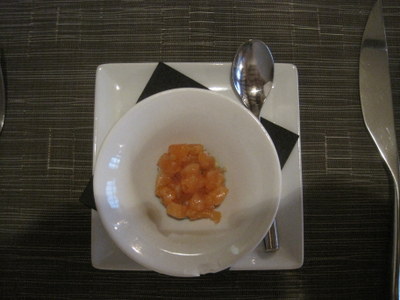
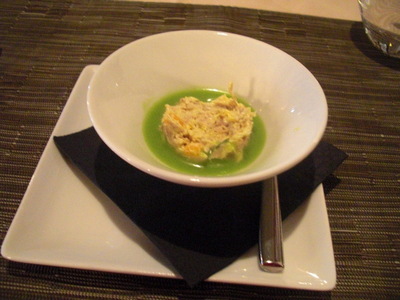 Dinner that night was at l'Auberge du Pont Vieux, just over the Pont Vieux (the old bridge) from the cathedral. We were delighted to learn, from the introductory page of the menu, that the chef had trained with Dutournier in Paris (originator of the wonderful Au Trou Gascon and the slightly less to our taste Carrée des Feuillants).
Dinner that night was at l'Auberge du Pont Vieux, just over the Pont Vieux (the old bridge) from the cathedral. We were delighted to learn, from the introductory page of the menu, that the chef had trained with Dutournier in Paris (originator of the wonderful Au Trou Gascon and the slightly less to our taste Carrée des Feuillants).
The amuse-bouche (shown at left) was a little timbale of cracked wheat topped with crushed avocado and diced raw salmon. When I apologetically admitted that I can't eat avocado, they whisked mine away and replaced it with a small timbale of rabbit rillettes in a pool of cold green pea soup. Delicious. David enjoyed his salmon and avocado.
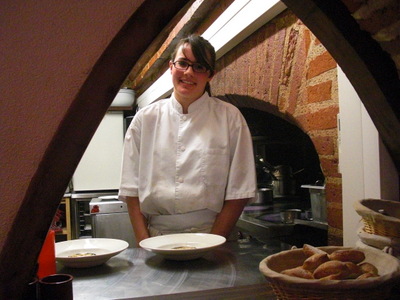
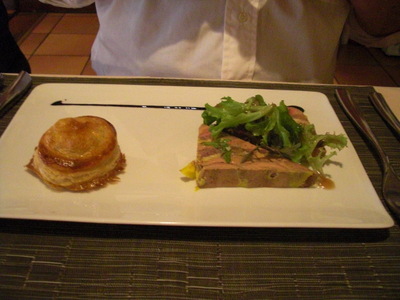 Just behind my right shoulder throughout the meal was this archway with a view into the kitchen, where assistant chef Manon assembled plates for serving. Each time I raised the camera, the waiter would call out "Smile, Manon," interrupting what she was doing, so I gave up trying to get photos of her in action.
Just behind my right shoulder throughout the meal was this archway with a view into the kitchen, where assistant chef Manon assembled plates for serving. Each time I raised the camera, the waiter would call out "Smile, Manon," interrupting what she was doing, so I gave up trying to get photos of her in action.
First course, David: Foie gras pressed into a loaf with duck confit. On the side a little turnip pie with sweet spices. Little tuft of salad on top and the obligatory streak of balsamic reduction behind.
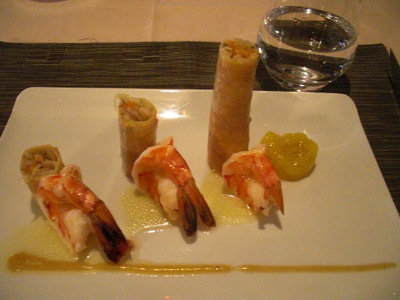
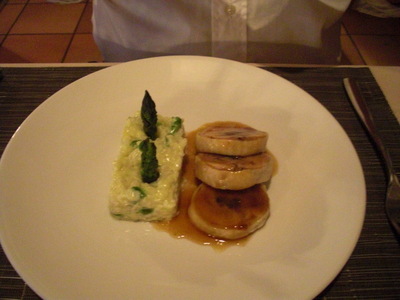 First course, me: Warm prawns with vegetable spring rolls and mango mustard.
First course, me: Warm prawns with vegetable spring rolls and mango mustard.
Main course, David: Medallions of chicken from the Landes (marshy region south of Bordeaux) stuffed with morels. On the side "Argenteuil" risotto (Argenteuil is an outlying suburb of Paris, but here it means "accompanied by asparagus"; they must grow asparagus in Argenteuil, or maybe they did in the past.
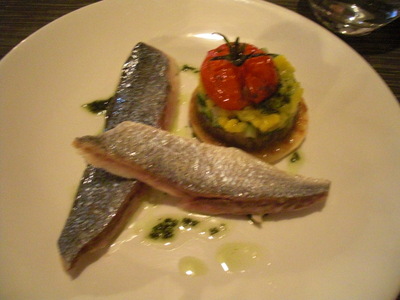
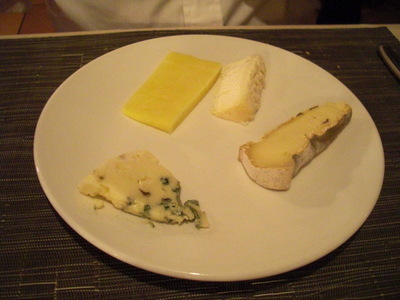 Main course, me: Filets of dorade (with an "o"; the loosely defined one) with a "tartlet" of southern vegetables (zucchini, eggplant, and tomato) and basil juice.
Main course, me: Filets of dorade (with an "o"; the loosely defined one) with a "tartlet" of southern vegetables (zucchini, eggplant, and tomato) and basil juice.
Cheese, both: For the cheese course, the waiter brought out a slab slate with just five cheeses on it: Laguiole, chabichou de Poitou (a chevre), St. Nectaire, Roquefort, and a Camembert that he described as "very strong." "Would you just like some of each?," he asked. "Except for the Camembert," David replied, edging nervously away from the cheese, which was making a break for the edge of the slate. So we had the other four, arranged on the plate, in the order I named them, clockwise from the top left.
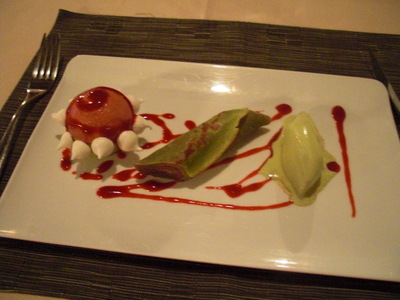
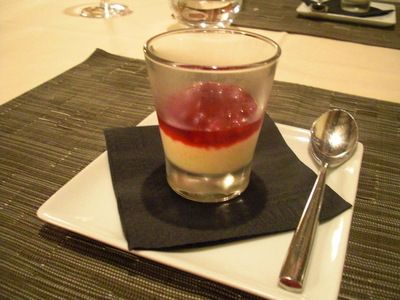 Dessert, both: Strawberries and pistachios. At the right, a quenelle of home-made pistachio ice cream. In the center, a pistachio crêpe rolled around a strawberry filling. At the left, a strawberry-pistachio sphere. The top half, clearly visible was a foamy, gelled cold mousse of strawberry, topped with a drizzle of strawberry syrup. The bottom half, alas obscured by the little meringue puffs pasted on around the equator, was the same thing, but in pistachio color and flavor. Cute and tasty.
Dessert, both: Strawberries and pistachios. At the right, a quenelle of home-made pistachio ice cream. In the center, a pistachio crêpe rolled around a strawberry filling. At the left, a strawberry-pistachio sphere. The top half, clearly visible was a foamy, gelled cold mousse of strawberry, topped with a drizzle of strawberry syrup. The bottom half, alas obscured by the little meringue puffs pasted on around the equator, was the same thing, but in pistachio color and flavor. Cute and tasty.
Postdessert (makes a change from mignardises and predesserts): Creamy polenta topped with a coarsely crushed sauce of raspberries.
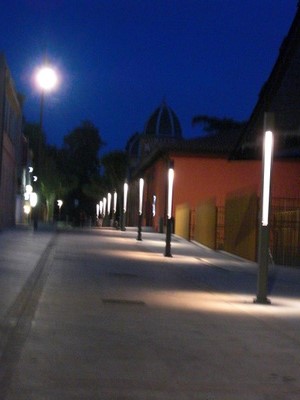 Another successful French dinner. We strolled home along this handy row of light sabers. Albi has a great deal of pedestrian-only space, some of it in the form of open squares; you do have to watch for the occasional lane of traffic that passes through, outlined by little waist-high posts. They have relatively recently cleared and pedestrianized a major artery through the middle of town (conveniently connecting our hotel to the pedestrian area around the cathedral), and this row of lights leads the way along it.
Another successful French dinner. We strolled home along this handy row of light sabers. Albi has a great deal of pedestrian-only space, some of it in the form of open squares; you do have to watch for the occasional lane of traffic that passes through, outlined by little waist-high posts. They have relatively recently cleared and pedestrianized a major artery through the middle of town (conveniently connecting our hotel to the pedestrian area around the cathedral), and this row of lights leads the way along it.
previous entry
List of Entries
next entry

 The very first thing that strikes you about Albi's Cathedral of Saint Cecilia—smacks you in the face, almost—is that it's made of bricks! And I mean a lot of bricks. It and its adjoining bishop's palace are the largest brick religious structure, and one of the largest brick structures of any kind, in the world. Somehow that detail had escaped us until we rounded that last corner and there it was, looming over us.
The very first thing that strikes you about Albi's Cathedral of Saint Cecilia—smacks you in the face, almost—is that it's made of bricks! And I mean a lot of bricks. It and its adjoining bishop's palace are the largest brick religious structure, and one of the largest brick structures of any kind, in the world. Somehow that detail had escaped us until we rounded that last corner and there it was, looming over us.
 We were at the door when the museum opened in the morning and hadn't finished by the time it closed at noon, so we retrieved our stuff from the thoughtfully provided locker room and headed out in search of lunch, which we found no farther away than the adjoining square at a place called "l'Herytage." Salads as usual, David's with raw ham and three cheeses on toast (mozzarella, chevre, and Cantal, this time I think) and mine with ham, bacon, and poultry gizzards.
We were at the door when the museum opened in the morning and hadn't finished by the time it closed at noon, so we retrieved our stuff from the thoughtfully provided locker room and headed out in search of lunch, which we found no farther away than the adjoining square at a place called "l'Herytage." Salads as usual, David's with raw ham and three cheeses on toast (mozzarella, chevre, and Cantal, this time I think) and mine with ham, bacon, and poultry gizzards.
 The usual line you get when you enter yet another another cathedral is "too bad the rood screen is gone; it was really spectacular" and "of course, back in the day, the walls and ceiling would have been painted rather than bare stone; just over there you can see some traces of paint." Not here!
The usual line you get when you enter yet another another cathedral is "too bad the rood screen is gone; it was really spectacular" and "of course, back in the day, the walls and ceiling would have been painted rather than bare stone; just over there you can see some traces of paint." Not here!
 At the left here, note that amazing 3-D effect of square posts protruding toward the viewer. That's all trompe l'oeuil; the wall is perfectly flat, so all the relief, 3-D effects, etc. are painted on. The same is true of the wall at the right above; it's all painted on flat plaster. The 3-D effect is even more striking in person. The ends of the "protruding" posts are all different, hand patterned to look like colored marble.
At the left here, note that amazing 3-D effect of square posts protruding toward the viewer. That's all trompe l'oeuil; the wall is perfectly flat, so all the relief, 3-D effects, etc. are painted on. The same is true of the wall at the right above; it's all painted on flat plaster. The 3-D effect is even more striking in person. The ends of the "protruding" posts are all different, hand patterned to look like colored marble.
 Because the painting carried on up the walls, past the clerestory windows, and onto the ceiling far above our heads, I was glad I'd brought my binoculars. You could sit there for hours, leaning back in a pew, studying all the images.
Because the painting carried on up the walls, past the clerestory windows, and onto the ceiling far above our heads, I was glad I'd brought my binoculars. You could sit there for hours, leaning back in a pew, studying all the images.
 Dinner that night was at l'Auberge du Pont Vieux, just over the Pont Vieux (the old bridge) from the cathedral. We were delighted to learn, from the introductory page of the menu, that the chef had trained with Dutournier in Paris (originator of the wonderful Au Trou Gascon and the slightly less to our taste Carrée des Feuillants).
Dinner that night was at l'Auberge du Pont Vieux, just over the Pont Vieux (the old bridge) from the cathedral. We were delighted to learn, from the introductory page of the menu, that the chef had trained with Dutournier in Paris (originator of the wonderful Au Trou Gascon and the slightly less to our taste Carrée des Feuillants).
 Just behind my right shoulder throughout the meal was this archway with a view into the kitchen, where assistant chef Manon assembled plates for serving. Each time I raised the camera, the waiter would call out "Smile, Manon," interrupting what she was doing, so I gave up trying to get photos of her in action.
Just behind my right shoulder throughout the meal was this archway with a view into the kitchen, where assistant chef Manon assembled plates for serving. Each time I raised the camera, the waiter would call out "Smile, Manon," interrupting what she was doing, so I gave up trying to get photos of her in action.
 First course, me: Warm prawns with vegetable spring rolls and mango mustard.
First course, me: Warm prawns with vegetable spring rolls and mango mustard.
 Main course, me: Filets of dorade (with an "o"; the loosely defined one) with a "tartlet" of southern vegetables (zucchini, eggplant, and tomato) and basil juice.
Main course, me: Filets of dorade (with an "o"; the loosely defined one) with a "tartlet" of southern vegetables (zucchini, eggplant, and tomato) and basil juice.
 Dessert, both: Strawberries and pistachios. At the right, a quenelle of home-made pistachio ice cream. In the center, a pistachio crêpe rolled around a strawberry filling. At the left, a strawberry-pistachio sphere. The top half, clearly visible was a foamy, gelled cold mousse of strawberry, topped with a drizzle of strawberry syrup. The bottom half, alas obscured by the little meringue puffs pasted on around the equator, was the same thing, but in pistachio color and flavor. Cute and tasty.
Dessert, both: Strawberries and pistachios. At the right, a quenelle of home-made pistachio ice cream. In the center, a pistachio crêpe rolled around a strawberry filling. At the left, a strawberry-pistachio sphere. The top half, clearly visible was a foamy, gelled cold mousse of strawberry, topped with a drizzle of strawberry syrup. The bottom half, alas obscured by the little meringue puffs pasted on around the equator, was the same thing, but in pistachio color and flavor. Cute and tasty. Another successful French dinner. We strolled home along this handy row of light sabers. Albi has a great deal of pedestrian-only space, some of it in the form of open squares; you do have to watch for the occasional lane of traffic that passes through, outlined by little waist-high posts. They have relatively recently cleared and pedestrianized a major artery through the middle of town (conveniently connecting our hotel to the pedestrian area around the cathedral), and this row of lights leads the way along it.
Another successful French dinner. We strolled home along this handy row of light sabers. Albi has a great deal of pedestrian-only space, some of it in the form of open squares; you do have to watch for the occasional lane of traffic that passes through, outlined by little waist-high posts. They have relatively recently cleared and pedestrianized a major artery through the middle of town (conveniently connecting our hotel to the pedestrian area around the cathedral), and this row of lights leads the way along it.